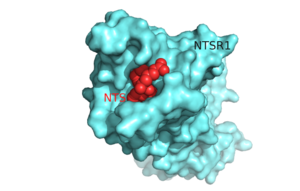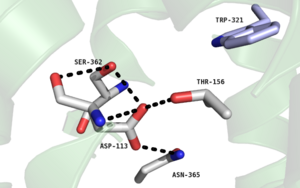Sandbox Reserved 1176
From Proteopedia
(Difference between revisions)
| (15 intermediate revisions not shown.) | |||
| Line 3: | Line 3: | ||
==Introduction== | ==Introduction== | ||
| - | [[Image:Surface_Protein_red.png |300 px|below|thumb|'''Figure 1'''.Top view of NTSR1 protein (blue) interacting with | + | [[Image:Surface_Protein_red.png |300 px|below|thumb|'''Figure 1'''.Top view of NTSR1 protein (blue) interacting with its ligand, NTS(red).]] |
| - | Neurotensin receptor 1 (NTSR1) is a '''[https://en.wikipedia.org/wiki/G_protein%E2%80%93coupled_receptor G-protein coupled receptor (GPCR).]''' GPCRs are a class of proteins with an extracellular binding domain and 7 transmembrane helices that assist in propagating a cellular response<ref name="SPGP"/>. This is accomplished by the binding of ligands to the GPCR outside the cell, causing a '''[https://en.wikipedia.org/wiki/Conformational_change conformational change]''' and activating a '''[https://en.wikipedia.org/wiki/Signal_transduction signal transduction]''' pathway via '''[https://en.wikipedia.org/wiki/Second_messenger_system second messengers]''' such as '''[https://en.wikipedia.org/wiki/Cyclic_adenosine_monophosphate cyclic AMP]''', '''[https://en.wikipedia.org/wiki/Inositol_trisphosphate inositol triphosphate]''', and '''[https://en.wikipedia.org/wiki/Diglyceride diacylglycerol]'''.<ref name="SPGP"/> The ligand for NTSR1 is the 13 amino acid peptide, neurotensin (NTS)<ref name="SONT">PMID:23051748</ref>, and the majority of the effects of NTS are mediated through NTSR1<ref name="SONT"/>. NTS has a variety of biological activities including a role in the '''[https://en.wikipedia.org/wiki/Leptin leptin]''' signaling pathways <ref name="Mice">PMID: 20211191</ref>, tumor growth <ref name="cancer">PMID:16887236</ref>, and '''[https://en.wikipedia.org/wiki/Dopamine dopamine]''' regulation <ref name="Schizophrenia">PMID:22596253</ref>.Recently NTSR1 was crystallized bound with the C-terminus of its tridecapeptide '''[https://en.wikipedia.org/wiki/Ligand ligand]''', <scene name='72/721548/Neurotensin/7'>NTS(8-13)</scene>. The shortened ligand was used because it has a higher potency and efficacy than its full-length counterpart<ref name="SONT"/>. Class A GPCRs bind their ligands within the '''[https://en.wikipedia.org/wiki/Transmembrane_protein transmembrane]''' core in a ligand binding pocket. The <scene name='72/721547/Hydrophobic_binding_pocket/ | + | Neurotensin receptor 1 (NTSR1) is a '''[https://en.wikipedia.org/wiki/G_protein%E2%80%93coupled_receptor G-protein coupled receptor (GPCR).]''' GPCRs are a class of proteins with an extracellular binding domain and 7 transmembrane helices that assist in propagating a cellular response<ref name="SPGP"/>. This is accomplished by the binding of ligands to the GPCR outside the cell, causing a '''[https://en.wikipedia.org/wiki/Conformational_change conformational change]''' and activating a '''[https://en.wikipedia.org/wiki/Signal_transduction signal transduction]''' pathway via '''[https://en.wikipedia.org/wiki/Second_messenger_system second messengers]''' such as '''[https://en.wikipedia.org/wiki/Cyclic_adenosine_monophosphate cyclic AMP]''', '''[https://en.wikipedia.org/wiki/Inositol_trisphosphate inositol triphosphate]''', and '''[https://en.wikipedia.org/wiki/Diglyceride diacylglycerol]'''.<ref name="SPGP"/> The ligand for NTSR1 is the 13 amino acid peptide, neurotensin (NTS)<ref name="SONT">PMID:23051748</ref>, and the majority of the effects of NTS are mediated through NTSR1<ref name="SONT"/>. NTS has a variety of biological activities including a role in the '''[https://en.wikipedia.org/wiki/Leptin leptin]''' signaling pathways <ref name="Mice">PMID: 20211191</ref>, tumor growth <ref name="cancer">PMID:16887236</ref>, and '''[https://en.wikipedia.org/wiki/Dopamine dopamine]''' regulation <ref name="Schizophrenia">PMID:22596253</ref>. Recently NTSR1 was crystallized bound with the C-terminus of its tridecapeptide '''[https://en.wikipedia.org/wiki/Ligand ligand]''', <scene name='72/721548/Neurotensin/7'>NTS(8-13)</scene>. The shortened ligand was used because it has a higher potency and efficacy than its full-length counterpart<ref name="SONT"/>. Class A GPCRs bind their ligands within the '''[https://en.wikipedia.org/wiki/Transmembrane_protein transmembrane]''' core in a ligand binding pocket. The <scene name='72/721547/Hydrophobic_binding_pocket/6'>hydrophobic binding pocket</scene> in NTSR1 is located at the top of the protein (Figure 1). NTSR1 also contains an '''[https://en.wikipedia.org/wiki/Allosteric_regulation allosteric]''' <scene name='72/721548/Na_bind_pocket/13'>sodium binding pocket</scene>, which is located directly beneath the ligand binding pocket and the two pockets are separated by the residue <scene name='72/721548/Trp321/1'>Trp321</scene><ref name="SPGP">PMID:26205105</ref>. NTSR1 has been mutated to exist in both <scene name='72/721548/Ntsr1-elf/6'>active</scene> and <scene name='72/721547/Ntsr1-gw5/8'>active-like</scene> states. This has led to a greater understanding of the structure of NTSR1 and how the structure influences its function. |
== Structure == | == Structure == | ||
===Ligand Binding Pocket=== | ===Ligand Binding Pocket=== | ||
On the extracellular side of the protein is the | On the extracellular side of the protein is the | ||
| - | <scene name='72/721547/Hydrophobic_binding_pocket/ | + | <scene name='72/721547/Hydrophobic_binding_pocket/6'>hydrophobic binding pocket</scene>. <ref name="SONT"/> |
One key residue in this pocket is a Phenylalanine at position 358, which takes part in a network of hydrophobic stacking interactions<ref name="SPGP"/>. These interactions stabilize the Trp321 and Tyr324 residues allowing Tyr324 to interact with the '''[https://en.wikipedia.org/wiki/C-terminus C-terminal]''' | One key residue in this pocket is a Phenylalanine at position 358, which takes part in a network of hydrophobic stacking interactions<ref name="SPGP"/>. These interactions stabilize the Trp321 and Tyr324 residues allowing Tyr324 to interact with the '''[https://en.wikipedia.org/wiki/C-terminus C-terminal]''' | ||
| - | <scene name='72/721547/ | + | <scene name='72/721547/Ligand_protein_interactions/8'>Leu13 residue of NTS ligand</scene> |
via '''[https://en.wikipedia.org/wiki/Van_der_Waals_force Van der Waals interactions]''' .<ref name="SONT"/><ref name="SPGP"/> | via '''[https://en.wikipedia.org/wiki/Van_der_Waals_force Van der Waals interactions]''' .<ref name="SONT"/><ref name="SPGP"/> | ||
Without the hydrophobic stacking interactions that are facilitated by the Phe358, this binding interaction would be destabilized. Trp321 also participates in these stacking interactions and serves as the boundary between the ligand binding pocket and the Na<sup>+</sup> binding pocket.<ref name="SPGP"/> | Without the hydrophobic stacking interactions that are facilitated by the Phe358, this binding interaction would be destabilized. Trp321 also participates in these stacking interactions and serves as the boundary between the ligand binding pocket and the Na<sup>+</sup> binding pocket.<ref name="SPGP"/> | ||
| Line 24: | Line 24: | ||
===Active-Like State=== | ===Active-Like State=== | ||
| - | The six amino | + | The six amino acid mutations for thermostabilization <ref name="SONT"/> were Ala86Leu, Glu166Ala, Gly215Ala, Leu310Ala, Phe358Ala, and Val360Ala. This protein was found to have NTS affinity similar to that of wild tpye NTSR1, and was named <scene name='72/721547/Ntsr1-gw5/8'>NTSR1-GW5</scene>. Along with this, the Na+ ion binding pocket was collapsed in this protein. However, NTSR1-GW5 did not have G-protein activity <ref name="SONT"/>. |
===Active State=== | ===Active State=== | ||
| Line 32: | Line 32: | ||
====Leu310==== | ====Leu310==== | ||
| - | <scene name='72/721548/L310/ | + | <scene name='72/721548/L310/6'>Leu310</scene> is crucial for interactions with the G alpha subunit by positioning Arg167 in the conserved <scene name='72/721548/Dery_motif/2'>D/ERY motif</scene><ref name="SPGP"/>. When Leu310 was substituted with alanine, Arg167 was able to form a stabilizing hydrogen bonding network with Asn257, Ser164 and Gly306, which oriented Arg167 in a position that was unfavorable for contacting the G alpha subunit. When residue 310 was converted back to leucine, this hydrogen bonding network was sterically unfavorable and Arg167 interacted with the G alpha subunit<ref name="SPGP"/> leading to the transduction of several different signals involved in dopamine regulation<ref name="Schizophrenia"/>, leptin signlaing<ref name="Mice"/>, and tumor growth<ref name="cancer"/>. |
| - | + | ||
====Phe358==== | ====Phe358==== | ||
| - | When this residue was mutated to an alanine <ref name="SPGP"/> the <scene name='72/721547/Hydrophobic_binding_pocket/ | + | When this residue was mutated to an alanine <ref name="SPGP"/> the <scene name='72/721547/Hydrophobic_binding_pocket/6'>hydrophobic stacking interactions</scene> of the ligand binding pocket were interrupted,resulting in a lack of G-Protein activity in NTSR1.<ref name="SPGP"/>.This supported the role of Phe358 as stated in the hydrophobic binding pocket section of this page. |
====Glu166==== | ====Glu166==== | ||
| Line 51: | Line 51: | ||
===Cancer Studies=== | ===Cancer Studies=== | ||
| - | Some tumor cells can secrete and express NTS and NTS receptors themselves suggesting that NTS '''[https://en.wikipedia.org/wiki/Autocrine_signalling autocrine]''', '''[https://en.wikipedia.org/wiki/Endocrine_system endocrine]''' and '''[https://en.wikipedia.org/wiki/Paracrine_signalling paracrine]''' regulation are possible. This leads to aggressive growth and tumor development. Injecting animals with NTS increased tumor growth and size, while injecting them with NTS antagonist had the opposite effect <ref name="cancer"/>. | + | Some tumor cells can secrete and express NTS and NTS receptors themselves suggesting that NTS '''[https://en.wikipedia.org/wiki/Autocrine_signalling autocrine]''', '''[https://en.wikipedia.org/wiki/Endocrine_system endocrine]''' and '''[https://en.wikipedia.org/wiki/Paracrine_signalling paracrine]''' regulation are possible. This leads to aggressive growth and tumor development. Injecting animals with NTS increased tumor growth and size, while injecting them with NTS antagonist had the opposite effect <ref name="cancer"/>. NTS regulation may be used in future cancer treatments. |
===Dopamine Regulation=== | ===Dopamine Regulation=== | ||
Current revision
| |||||||||||
References
- ↑ 1.00 1.01 1.02 1.03 1.04 1.05 1.06 1.07 1.08 1.09 1.10 1.11 1.12 1.13 1.14 1.15 1.16 1.17 1.18 1.19 1.20 1.21 1.22 1.23 Krumm BE, White JF, Shah P, Grisshammer R. Structural prerequisites for G-protein activation by the neurotensin receptor. Nat Commun. 2015 Jul 24;6:7895. doi: 10.1038/ncomms8895. PMID:26205105 doi:http://dx.doi.org/10.1038/ncomms8895
- ↑ 2.0 2.1 2.2 2.3 2.4 2.5 2.6 2.7 White JF, Noinaj N, Shibata Y, Love J, Kloss B, Xu F, Gvozdenovic-Jeremic J, Shah P, Shiloach J, Tate CG, Grisshammer R. Structure of the agonist-bound neurotensin receptor. Nature. 2012 Oct 25;490(7421):508-13. doi: 10.1038/nature11558. Epub 2012 Oct 10. PMID:23051748 doi:http://dx.doi.org/10.1038/nature11558
- ↑ 3.0 3.1 3.2 3.3 Liang Y, Boules M, Li Z, Williams K, Miura T, Oliveros A, Richelson E. Hyperactivity of the dopaminergic system in NTS1 and NTS2 null mice. Neuropharmacology. 2010 Jun;58(8):1199-205. doi:, 10.1016/j.neuropharm.2010.02.015. Epub 2010 Mar 6. PMID:20211191 doi:http://dx.doi.org/10.1016/j.neuropharm.2010.02.015
- ↑ 4.0 4.1 4.2 Carraway RE, Plona AM. Involvement of neurotensin in cancer growth: evidence, mechanisms and development of diagnostic tools. Peptides. 2006 Oct;27(10):2445-60. Epub 2006 Aug 2. PMID:16887236 doi:http://dx.doi.org/10.1016/j.peptides.2006.04.030
- ↑ 5.0 5.1 5.2 Griebel G, Holsboer F. Neuropeptide receptor ligands as drugs for psychiatric diseases: the end of the beginning? Nat Rev Drug Discov. 2012 May 18;11(6):462-78. doi: 10.1038/nrd3702. PMID:22596253 doi:http://dx.doi.org/10.1038/nrd3702


